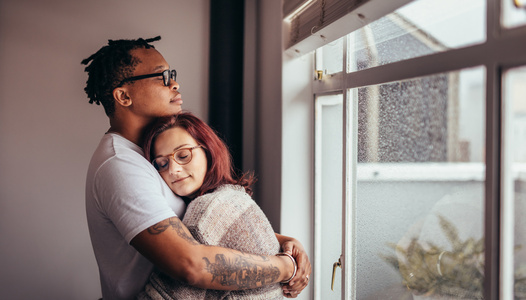
Marriage is a sacred bond between two people. You meet. You get to know one another, and you soon become inseparable — each of you growing to love each other in such a way that you no longer want to spend a moment apart.
All couples want this kind of storybook ending.
Yet, any couple who has been married longer than two minutes can tell you, it’s not that easy. Marriages have struggles. People are people, and when two get together there is no telling how your unique personalities and individual chemistries might work together.
And with 17 percent of marriages taking place among multiracial couples (compared to 3 percent just 50 years ago) racial identity is just another element in that chemical reaction to consider when calibrating your ideal “love reaction.”
To gain insight on this very important topic, we reached out to our own Paula Shulman, MA, LMFT, who founded and directed the Biracial Families Resource Center in New York City in 1983 and the Multiracial Group of Western Massachusetts in 1987. She has been a diversity trainer since the 1970’s and has served multiracial couples since 1983, from New York City to Pioneer Valley.
Paula has formed groups for people in multiracial families, holding monthly gatherings where children could see and interact with families who “look like” them. She has also hosted seminars and other events, during which speakers led workshops on the unique strengths and challenges of multiracial families.
In short, Paula has a wealth of expertise on the topic. Throughout the blog below, she provides invaluable advice on how to keep the “love alive” despite the distinct pressures multiracial couples still face in today’s society.
Is Love and Happiness Truly Enough?
In a perfect world, people would be open-minded and have an innate understanding that those of different racial and cultural groups have unique experiences and differences in values. We would be just as comfortable asking about racial/cultural experiences as we would be with sharing whether we like animals or what we enjoy doing in our leisure time.
Unfortunately, our society is far from ideal. Racism and discrimination are rampant. From crude coworkers to unaccepting family members, everyone we meet comes to the table with their biases and prejudices.
Our families are no different — such that the American Association for Marriage and Family Therapy (AAMFT) has even coined a term, racial devaluation, to describe the exclusionary behaviors of our family members towards a spouse of a different racial identity.
According to the AAMFT, racial devaluation occurs when negative attitudes and behaviors are expressed toward anyone outside of the family origin. These attitudes often manifest themselves as derogatory comments or actions aimed at their relative’s loved one.
Because racism is such an intense experience and impacts the couple, people in multiracial relationships can benefit from marriage counseling that is both research-based and founded on principles of celebrating racial/cultural differences and inclusion.
Love and happiness in a marriage will get you from the altar to the chapel exit.
However, once you enter the real-world, your eyes will do a double take. Two people can live in love and happiness, but if outside influences threaten the joy, peace, and patience, you have in each other, this cruelty can hurt the foundation you have laid with your spouse.
And while it is true that all relationships have struggles, when you add racial/cultural differences to the equation, couples struggle on a whole new level. But the good news is that there are keys to overcoming racial barriers the outside world throws your way. It becomes imperative to develop ways to protect the relationship from the negativity that stems from racism, biases, and ignorance. If you are in an multiracial relationship or marriage, here are tips to help you and you and your partner.
Understanding Your Partner’s Perspective
 The first step is knowing your partner inside and out. This is about more than their favorite color or how they take their coffee. It’s about developing your Love Maps. Learn your partner’s history, what worries them, their fears and joys, and their dreams and aspirations.
The first step is knowing your partner inside and out. This is about more than their favorite color or how they take their coffee. It’s about developing your Love Maps. Learn your partner’s history, what worries them, their fears and joys, and their dreams and aspirations.
As any first-grade teacher would tell you, if you don’t know the answer to a question, the best way to learn is to ask.
When In Doubt, Ask
If you have a spouse with a different background, learn to appreciate your spouse for who they are. Also, be intentional and consistent about your learning. Then, your bond can move beyond the mere “I love you” stage and toward the “I love you because ______.” Loving your partner for who they are includes understanding and appreciating your different upbringings, life experiences, family histories, cultures, and racial sensitivities. It means listening and understanding what it is like for the partner who encounters racism in the world on a daily basis. It also means examining one’s own privileged status, whether it be white privilege, socio-economic privilege, or any other privileged status that one partner may have and the other may not.
Paula Shulman emphasizes the importance of developing a whole set of questions to understand your partner. As Paula states, “People in multiracial relationships really do need to discuss their histories and experiences. Some questions to ask include: When was the first time you became aware of your racial identity? How did this occur? Who (if anyone) was there to help you process this? How do you experience things around racial identity differently now? What do you need from me to support you in healing from painful experiences? What are you proud of in your culture, and how have you learned to cope?”
Understand Your Partner’s Love Map
It is one thing to ask an open-ended question of your partner; it is another thing to listen to their answer. Most controversial questions we ask tend to be rhetorical. We don’t expect an answer; we want to vent frustration about a situation or to express an irritation on a subject. To get to know your partner, you need to understand where they are coming from.
For people in some racial groups, where you sat mattered. If you were to sit at a table, in a room, on a bus, or even in public — it mattered. Choosing the wrong seat could draw ridicule, racist words, or worse. Someone from a different racial identity could not understand those feelings. So, to understand your spouse’s position, you need to ask those difficult questions, then truly listen. For Dr. Gottman these listening instances are part of understanding your partner’s “love map.” and are crucial to the longevity of a union or marriage.
While telling your partner that the racism they experience is “not real” is never allowed, Paula points out similar statements you should avoid, such as:
- “You are too sensitive.”
- “Why can’t you just get over it?”
- “That person didn’t really mean it.”
- “They have good intentions.”
- Or….
- “You’re just so clueless.”
- “You don’t even want to understand what it’s like for me.”
- “You [insert race] people live in a fantasy world.”
Instead, Paula suggests to adopt patterns of thinking such as: “I love this person. I choose to be with them. I keep my heart, eyes, and mind open to learning, validating, and supporting them in their experience. I choose to be their biggest ally, cheerleader, and support person.”
“While there are many things you may not understand at first,” Paula says, “with time, you can develop a stronger understanding of one another’s experiences and forge a strong bond between you that will bolster you through these big challenges.”
Respond With Love & Care
Also, remember to give your partner your full attention. Use full eye contact. Avoid distractions. Receive their response, process it, and convey understanding. Listen, do not discount.
It is also worth mentioning, that if a situation feels real enough to your partner then it is real to you, too. This is crucial within multiracial marriages and relationships. Their concerns of negative influence, ridicule, and even blatant intolerance are important. Embracing them as your own is important to the longevity of your relationship.
Paula advises that each partner “has the other partner’s back (and so much more).”
“While family member or friends may have difficulty embracing your partner,” adds Paula, “you should strive for an open, understanding, and empathetic form of solidarity with one another. That way, you can meet the challenges you will each face and deal with overt, and covert, racism, bias, and prejudice. It is also important to build a community of people who “get” you as a couple, support you, and can serve as listening ears for you to turn to when your partner is not available.”
Dealing with Pressures of Intolerance in the Family
 Every relationship is different. Some multiracial couples can form a “live and let live” acceptance with their family members, while others need to allow time for family members to understand, grow, and accept their differences. Often, this occurs over a (sometimes very long) period of time. Meanwhile, each partner will have different ideas about what they are willing or able to “take” from their partner’s family.”
Every relationship is different. Some multiracial couples can form a “live and let live” acceptance with their family members, while others need to allow time for family members to understand, grow, and accept their differences. Often, this occurs over a (sometimes very long) period of time. Meanwhile, each partner will have different ideas about what they are willing or able to “take” from their partner’s family.”
“Talk deeply with one another,” Paula suggests. “Also, utilize therapists to facilitate these conversations, so that you can create a sense of solidarity and support for one another’s needs. This might include standing up for yourselves within your families and setting clear boundaries lines — ones which no family member is allowed to cross.”
Paula goes on to emphasize the fact that overt discrimination is completely unacceptable. “Whether out of fear or ignorance on the part of the family member, or overt bias, prejudice, or stereotypical ideas, these behaviors are just not okay. Sometimes, the issue involves deep psychological problems. Other times, it is simply caused by parents who want to control their “child,” or superficial issues, such as what the “neighbors” might think. What to do about these issues depends a lot on the unique family. However, in any situation, the couple must take a stand.”
Acceptance is Key
We can manage the atmosphere in our homes, but we also have to deal with what happens outside our four walls. You can work together as a couple to find different ways of meeting obstacles you face, including social action and spending time with people who support you as a multiracial couple. Also, make a point to decide together how you will meet new challenges. When something comes up, make a point to talk about it and meet it with a sense of unity.
The way you react to an issue has the potential to either exacerbate the situation or snuff it out. Remember to be sensitive and compassionate towards your partner and discuss/share with your partner how racist words and attitudes make you feel. Understanding and validating your partner’s experience is critical to maintaining a safe bond between you.
Respect Your Partner
As new issues arise, you must always respect your partner’s feelings about them. Telling them to ignore the other party is not always the best (or wanted) piece of advice. Ignoring it will not stop the issue, nor will it resolve your partner or spouse’s angst. Respecting your partner also means standing beside them. It is completely normal to not be able to fully understand what it is like to walk in another person’s shoes. However, listening, validating, and making room for their experience can go a long way in decreasing their sense of loneliness and offering support.
Support & Challenge
Remind your spouse that every situation is temporary and that your love for them will not change through outside influences. Encourage them to talk about their feelings, and to lean on you when needed. Support means to challenge your partner to achieve their hopes and dreams. One person’s opinion cannot dampen the feelings you have for each other, and it will not inhibit you from achieving all you planned for your relationship and your life.
Build Character Through Communication
One final aspect is communication. If one is silent about their struggles, then those problems only build up. Talking honestly with your spouse or partner helps you build your bank of shared experiences. Both the good and bad. It’s easy to stand beside someone during good times. Character is revealed in the heart of battle. In fact, fighting through the negative will strengthen your relationship far more than a positive experience ever could.
Final Thoughts
A core tenet of the Gottman Method is creating a sense of shared meaning with your partner or spouse. Being a member of a multiracial relationship or marriage presents a unique opportunity for you to do just that with your loved one. By making a point to understand your partner’s dreams, along with the specific challenges they may face, you can both work toward forging a relationship language that is rooted in trust and cemented in respect and love.
Being a member of a multiracial and/or multicultural couple opens up enormous opportunities to grow, learn, expand, and develop one’s view of the world, and develop new ways of living life to the fullest. Whether through the creation of new holidays, family meals, or rituals of connection, make a point to embrace and celebrate the doors that having a diverse family culture opens to you both.
When you trust that your partner has your back, and you have theirs, there is no limit to what you can achieve together.
At NCCT, our therapists are well-versed in the Gottman Method, Emotionally Focused Therapy and other leading couples therapy methodologies. More importantly, we are also passionate about supporting multiracial couples, helping you and your partner build bridges toward one another that are rooted in love, respect, and understanding.
We offer private, intensive 2-Day and 3-Day couples retreats, marriage retreats and weekly couples therapy sessions. We also have new extended hours and team members to meet a growing demand for expert, research-based couples therapy in the New England area and across the US.
